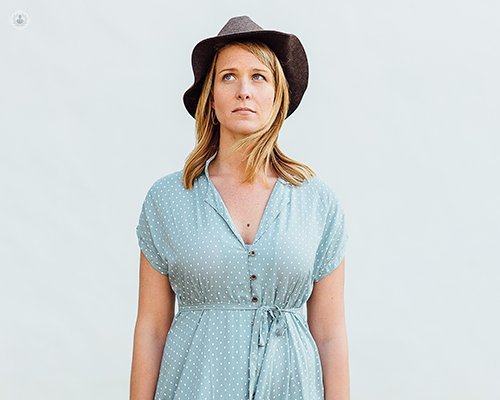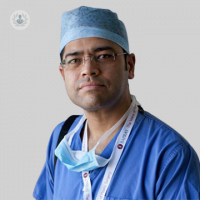A little bit about breast lifts
Written by:Breast lifts using an implant are considered the most difficult procedure in the field of cosmetic breast surgery. There a various reasons which make the procedure difficult. In this article, we’ll take a closer look at some of the most important aspects, as revered consultant plastic and reconstructive surgeon, Mr Naveen Cavale, explains in more detail.

When should you consider a breast lift?
The term breast lift is the name given to the corrective procedure for breasts that have begun to droop. It is often combined with implants or fat transfer, as an uplift alone can sometimes result in the breasts appearing smaller. Therefore, breast lift surgery with implants or fat transfer can be performed when the patient wishes to have both higher and fuller breasts.
What causes the breasts to droop?
Breasts are comprised of glands and fat encompassed in skin. The difference between one breast and another is the percentage of these components. For example, there are breasts with large glands and little fat and others that have more fat tissue than glands.
If we consider that glands weigh more than fat, a very glandular breast weighs more and depending on the skin that surrounds it will have more tendency to become droopy compared to the ones which have higher levels of fat. Additionally, the quality of the skin around the breast is an important factor.
There are ligaments that support the breast, but these are intrinsic to the type of skin of the breast. So, one can say that breasts with thicker skin will sag less and more slowly than breasts with thinner skin.
There are three main factors that greatly affect the breasts. Female hormones linked to pregnancy and breastfeeding increase the size of the glands making the breasts weigh more and stretching the skin. Repeating pregnancy and breastfeeding will cause these effects and will be most evident on thinner-skinned breasts, causing them to sag.
Weight changes also have an effect on this. Weight gain increases the fat content of the breasts, making them heavier and stretching the skin. When this weight is lost, the distended skin fails to “shrink” back, leaving the appearance of droopy breasts. Therefore, breasts that may be somewhat already droopy can be observed in young women if they have thin skin and experience weight gain and/or loss.
Ageing can also cause breast sag. As a women gets older, the ligaments that make up the breast tissue stretch and lose elasticity. As a result, breast fullness is compromised as the underlying support system of tissue and fat diminishes. This change is particularly evident in menopause.
What are different degrees of breast ptosis?
There are different degrees of breast ptosis (droopy breasts) including grade I (mild), grade II (mild to moderate) and grade III (severe). Along with the degree of breast ptosis, the quality and composition of the tissues must be taken into consideration. For example, a Grade 2 breast ptosis with a very fine skin will be more difficult to treat than another within the same grade but with thicker skin. To ensure the right corrective procedure is carried out, each case must be understood and diagnosed on an individual basis.
What does the operation entail?
The surgical technique of a breast lift consists of rebuilding the components of the breast to lift them, giving them a more beautiful shape. Cohesive silicone gel implants are added to increase the size of the breasts and skin is repaired so it covers the new contours of the breast, removing any excess skin if required. Corrective positioning is also made to the areolas to fit the new shape.
How is the implant size determined?
Most patients already have an idea of the breast size they wish to achieve, but it must be consulted with a surgeon. It’s important to remember that the implant, whether it is placed above or behind the pectoral muscle, does add weight to the breast and must be supported by the skin whose tensile properties are not affected by surgery.
Therefore, to achieve lasting results, it’s important to not use an implant that is too large. Many women think implants never become saggy. Sadly, that is not true. Generally, the bigger they are, the saggier they will become later on in life.
How large are the incisions for this procedure?
Very often, in the case of mild breast ptosis, the correction can be carried out by just placing an anatomical prosthesis with full projection through an inframammary incision of only 4.5cm long. When the patient is a grade II, there are two options depending on the quality of the skin. If the skin is of good quality, the prosthesis will be implanted, as in mild cases, through a 4.5cm inframammary incision. The excess skin around the areola is removed, decreasing it in size and leaving a scar.
If the skin is of poor quality, the surgeon will have to remove more of it and there will also be a vertical scar from the areola to the fold under the breast. In Grade III cases of breast ptosis, when the lower pole of the breast rests completely on the rib cage and the quality of the tissue is usually not the best, there is no alternative but to remove as much skin as possible.
In this case, the scar will be shaped like an inverted T or an anchor. Deciding what to do in each case requires a first consultation visit with enough time to assess all variables, including the pros and cons.
What is the recovery process?
Following the procedure, we advise that you rest at home for the first few days and ensure you have support with household tasks and childcare duties. You may need to take around 2 weeks off work and sports/exercise will need to be avoided for approximately six to eight weeks.
Making incisions in the breasts will require dressings to be applied. These will be need to kept dry whilst the wounds heal, so showering is not recommended for 1 week. Following this time, a warm bath or low-pressure shower is preferred rather than the use of a power shower. Normally, there are a number of follow-up appointments, one week, six weeks and three months after the procedure.
During the first appointment, we will assess the wounds and remove the dressings if the wounds are sufficiently healed. We may ask you to wear a supportive sports bra for three months following the procedure to aid healing and recovery.
To book a consultation with Mr Naveen Cavale, head on over to his Top Doctors profile.


